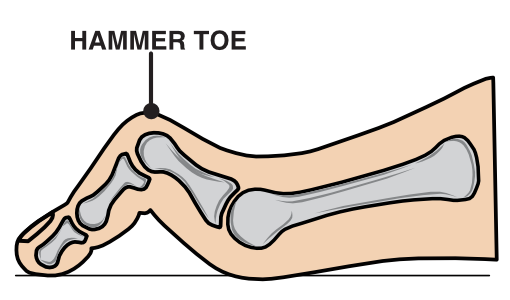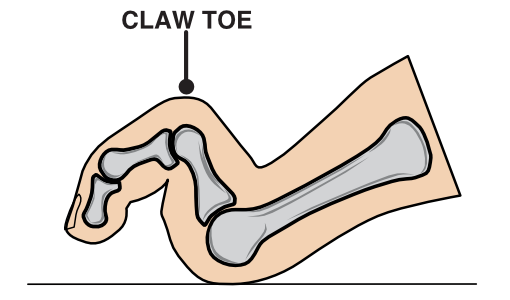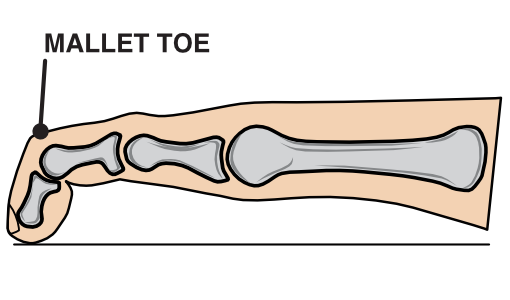Hammertoe is a catch-all term for a number of malalignments affecting the lesser toes.
Hammertoes, claw toes, mallot toes are some of the most common foot deformities that we see in patients. This affects the middle joints of the smaller toes, causing toes to bend downward. This problem can also lead to pain, swelling, and stiffness. Many have painful corns or thickened toenails. While our podiatrist, Dr. Douglas Robinson, can treat these issues through nonsurgical methods, sometimes surgery is necessary in more severe and progressive cases.
What kind of Lesser Toe Deformities are there?
The most common lesser toe deformities are hammer, claw, mallet and overlapping toes. They can occur due to an imbalance between the muscles and tendons within your foot that hold your toes straight. These changes are usually flexible but can become fixed in their new position over time.
Hammer Toe
A hammer toe is when the proximal interphalangeal joint (shown) bends down. Due to the change in shape this can result in a corn/callous developing on the top and/or tip of your toe. This is most commonly seen in the second toe but can occur in any of the smaller toes. If left untreated can become fixed over a period of time.
Claw Toe
A claw toe is when the proximal and distal interphalangeal joints bend down (shown). Due to this change in shape, you may experience pain and calluses or corns over the top and/ or tip of your toe. If left untreated, the severity of the deformity can increase over time.
Mallet Toe
A mallet toe is when the distal interphalangeal joint bends down, (shown). Due to this change in shape you may experience pain and calluses or corns over the top and/ or tip of your toe. If left untreated it can become fixed over a period of time.
Coming in for a Consultation
Whether you're looking to get a diagnosis or you want to discuss your treatment options when it comes to these toe issues, we will first examine your foot and its mobility. We will also run X-rays to check the severity of the deformity. From there, we will discuss the symptoms you may experience as a result of this condition, and ways to slow the progression.
Creating a Treatment Plan
Once we have analyzed and examined your feet, we can begin crafting your very own treatment plan. Most patients are relieved to find out that conservative treatment options such as modified activities, footwear, and foot exercises can often provide relief; however, if your toe problem isn't responding to home treatment and nonsurgical care, or if your deformity is large and painful, these are signs that you may benefit from surgery.
Surgery to Correct Mal-Aligned Toes
If you need to have corrective surgery to repair the deformed toe, Dr. Robinson specializes in these types of foot surgeries. Procedures are performed under local anesthesia, which will numb the treatment area. The procedure takes less than an hour and patients will go home the very same day.
Correcting a mishappened toe is fairly straightforward and easy, depending on the severity and the number of toes we need to correct. Several techniques may be used to correct the deformity. The most common technique is a soft tissue procedure called a Flexor Tenotomy and Capsulotomy. This reduces the contracture so the toe lies flatter. Healing time is initially less than a week.
Your feet must get the proper treatment and care they need if you are dealing with malaligned toes. By catching these issues early, Dr. Robinson can help you manage symptoms without ever having to resort to surgery.


